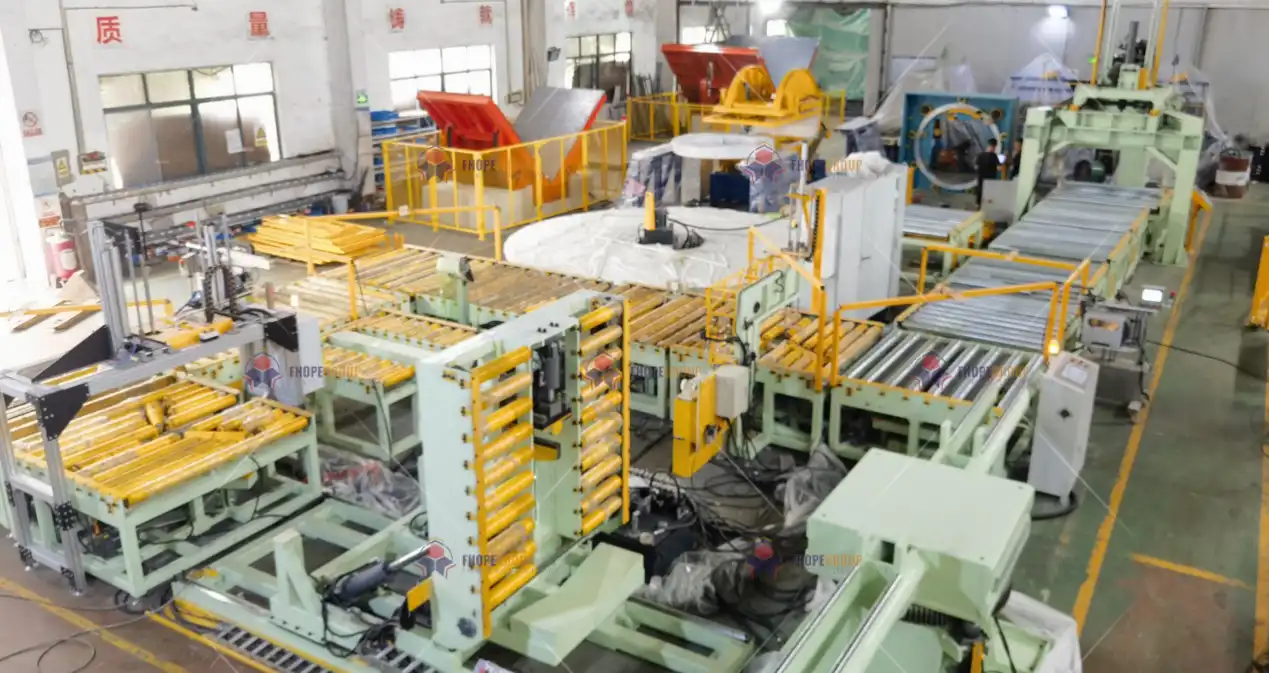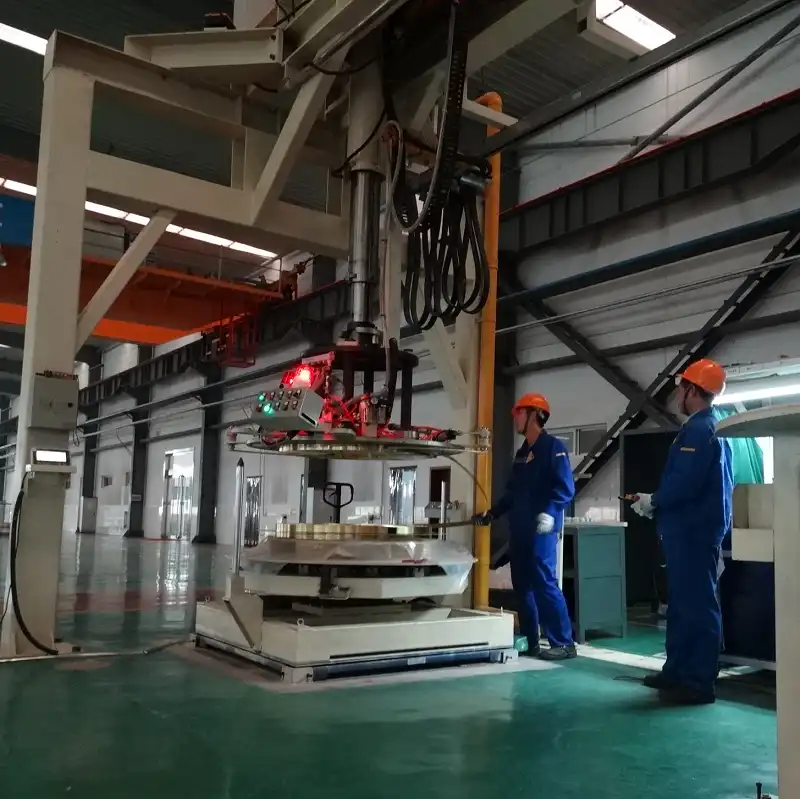As a manufacturer, FHOPE providing the packing solution for steel industry with turnkey projects.
The solution includes, cold roll steel coil packing line that indludes the master coil wrapper, strapping machine, coil car system...
Automatic steel wire coil packing system includes, wire rod coil strapping machine, wrapping machine, strapping machine...
Slitting coil packing line for economic coil packing line or automation in coil handling, packing, storage handling...The automatic strapping machine on the conveyor for eye through strapping with precise positioning per each single strip.
The inovation of the packing system will be able to installation and training with full knowledge of the documents. And after service team.
FHOPE had becomed a full range supplier and a full range coil packing system manufacturer.
Steel Industry Packaging
-

Copper coil packing IN MALAYSIACopper coil packing line solution in Malaysia, which showcases our commitment to working closely with our customers to deliver the best possible packaging solutions. Our state-of-the-art technology ensures that your copper coils are safely and securely packaged, ready for distribution. Trust us to provide the best possible packag...
-

Slitting coil packaging lineSlitting Coil Packaging Line Coil packaging line is essential system to increasing the coil handling capacity when doing any slitting operation. The purpose of carefully designed in slitting coil strapping binding line is to make your process of binding, sorting and storing coils more efficient. It should be noted that the speed ...
-

AUTOMATION IN THE WIRE COIL PACKING SOLUTIONSAUTOMATION IN THE WIRE COIL PACKING SOLUTIONS For the steel wire industry, there are many types of wire products such as high-carbon steel wire, alloy steel wire, wire rope, stainless steel wire, Aluminium alloys wire...So the handling and packing machine need to be designed according to the production. Following machines divisio...
-

Slitting coil packing line for saleSteel coil packing line is an excellent choice for those on a budget, as it helps to streamline the coil handling and packaging process. By compacting these processes together, we make it easier for you to package your steel coils quickly and efficiently. Trust our state-of-the-art technology to deliver the best possible packagin...
-

Coil wrapping machine with Drawing-Back DesignWhen it comes to steel wire production, it's important that your packing machine is flexible and able to accommodate different production plans. However, traditional coil wrapping machines often struggle with big ring wrapping for small coils due to issues with stretch film tension during the film application process. That's why ...
-

Automatic coil packing machine with holding armAutomatic horizontal coil packing machine with holding arm is specially designed for efficiently packaging small OD coils with both paper and film. This state-of-the-art technology streamlines the packaging process, ensuring that your coils are safely and securely packaged and ready for distribution. Trust us to deliver the best ...
-

Block roller station for Rotating CoilBlock roller station is specifically designed to accommodate rotating coils weighing up to 38T. This roller station is designed with the steel coil size and weight in mind, while also taking into account the process of steel belt strapping. With our state-of-the-art technology, we ensure that your coils are safely and efficiently...
-
.jpg)
Steel coil wrapper machine for PC wire coilOur Fhope team specializes in producing vertical steel coil wrapping machines that can be used with a variety of packing materials, including paper, film, and woven sheets. These machines are specially designed for steel coil packaging and can be used with PC wire coils, steel metal coils, copper coils, and aluminum coils of vari...
Steel Coil Packaging Projects
-

Copper coil packing IN MALAYSIACopper coil packing line solution in Malaysia, which showcases our commitment to working closely with our customers to deliver the best possible packaging solutions. Our state-of-the-art technology ensures that your copper coils are safely and securely packaged, ready for distribution. Trust us to provide the best possible packag...
-

Slitting coil packaging lineSlitting Coil Packaging Line Coil packaging line is essential system to increasing the coil handling capacity when doing any slitting operation. The purpose of carefully designed in slitting coil strapping binding line is to make your process of binding, sorting and storing coils more efficient. It should be noted that the speed ...
-

AUTOMATION IN THE WIRE COIL PACKING SOLUTIONSAUTOMATION IN THE WIRE COIL PACKING SOLUTIONS For the steel wire industry, there are many types of wire products such as high-carbon steel wire, alloy steel wire, wire rope, stainless steel wire, Aluminium alloys wire...So the handling and packing machine need to be designed according to the production. Following machines divisio...
-

Slitting coil packing line for saleSteel coil packing line is an excellent choice for those on a budget, as it helps to streamline the coil handling and packaging process. By compacting these processes together, we make it easier for you to package your steel coils quickly and efficiently. Trust our state-of-the-art technology to deliver the best possible packagin...
-

Coil wrapping machine with Drawing-Back DesignWhen it comes to steel wire production, it's important that your packing machine is flexible and able to accommodate different production plans. However, traditional coil wrapping machines often struggle with big ring wrapping for small coils due to issues with stretch film tension during the film application process. That's why ...
-

Automatic coil packing machine with holding armAutomatic horizontal coil packing machine with holding arm is specially designed for efficiently packaging small OD coils with both paper and film. This state-of-the-art technology streamlines the packaging process, ensuring that your coils are safely and securely packaged and ready for distribution. Trust us to deliver the best ...
-

Block roller station for Rotating CoilBlock roller station is specifically designed to accommodate rotating coils weighing up to 38T. This roller station is designed with the steel coil size and weight in mind, while also taking into account the process of steel belt strapping. With our state-of-the-art technology, we ensure that your coils are safely and efficiently...
Better Value Control: With the advancement of new technology — specifically machine vision utilizing artificial understanding, which let the computers to “view” loopholes for example human resources do — this is vital. The designers of some modern quality control systems are going as distant as to say that their systems don’t make errors and can catch approximately 100% of errors.
In the past, automation solutions weren’t always strong enough to wholly automate the job of supporting coil packaging line quality control. At the same time, the mundane and repeated work of examining all items was left to human workers.
Reduced Labor Costs: Presently, with the unemployment rate attaining momentous lows in the world and consumer demand advancing to rise, many steel industry companies are starting to feel the effects of a progressively competitive labor market. Workers have more alternatives for employment, driving up gross and finally increasing labor charges.
One feasible solution to this issue is automation the coil packaging. By automating as much of the packaging line as feasible, companies can make sure that workers are only being hired when they are required, and then take away workers from the packaging procedure when they aren’t required.
Better Information Access: More and more frequently, designers of packaging line automation systems in the steel industry are building the design of human-machine connections which a high priority. These better HMCs can make it simpler for workers and managers to introduce information which is appropriate to individual machines and packaging line procedures.
Automated packaging lines can provide notable benefits for product manufacturers. By taking on the liability of repeated and mundane tasks, these systems can lessen the risk of ergonomic injury and move the workers to higher-value tasks where they’re more extremely required. These systems can also increase productivity and make better the quality control steps, all of which changes to better success in the long run.
SHOWCASE & NEWS
Product Inquiry
Our team will reply in 24 hours
![]() Email: info@fhopepack.com
Email: info@fhopepack.com
![]() Whatsapp: 0086-13951501635
Whatsapp: 0086-13951501635












